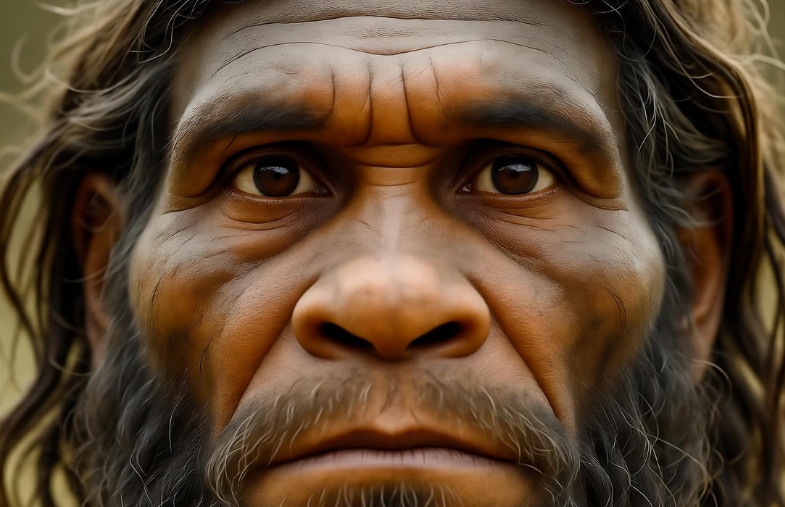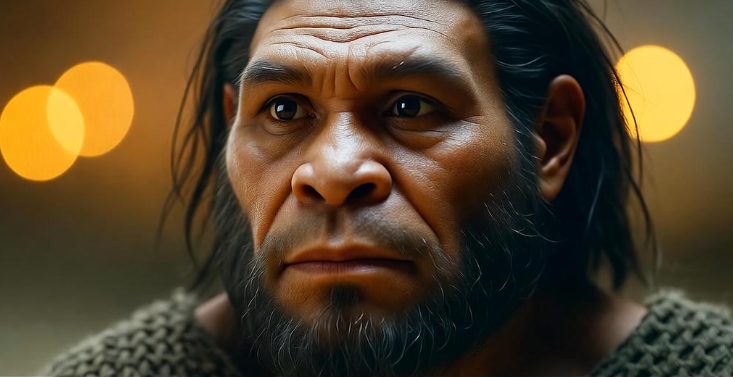For years, Neanderthals have been painted as primitive, cave-dwelling brutes — slow, wild, and less capable than modern humans. But here’s the truth: that picture is completely outdated. 🧠 Modern science has flipped the script, showing that Neanderthals were much more intelligent, creative, and emotionally complex than we ever imagined. The deeper researchers dig into their history, the clearer it becomes that Neanderthals were not the dumb cousins of humans — they were brilliant survivors in their own right.
The misunderstood image of Neanderthals
The old idea of Neanderthals being slow-witted comes from early discoveries in the 19th century. When scientists first found their fossils, they noticed thick skulls and strong bones — which they wrongly took as a sign of primitive thinking. Back then, bigger meant “dumber.” They assumed Neanderthals couldn’t think abstractly or plan ahead like us.
But with modern technology — DNA analysis, CT scans, and archaeology — everything has changed. We now know that Neanderthals had brains slightly larger than modern humans! 🤯 Their brain size wasn’t the problem. It’s how they used it that makes them truly fascinating.
Their intelligence wasn’t just about survival — it was about innovation
Think about it. Surviving the harsh Ice Age wasn’t easy. To live through freezing temperatures, Neanderthals had to plan, adapt, and innovate constantly. Evidence shows they built shelters, used fire strategically, and made tools that were complex and efficient.
Archaeologists have found weapons made from stone, bone, and wood — carefully designed for hunting specific animals. They even repaired their tools when they broke instead of throwing them away. That’s early recycling right there. 🔧
They didn’t just follow instinct; they thought ahead. When hunting mammoths or bison, they planned group strategies — trapping animals in narrow valleys or driving them toward cliffs. Such teamwork needs intelligence, communication, and leadership.
| Skill | Evidence | Why It Matters |
|---|---|---|
| Tool-making | Stone tools found with wear marks | Shows problem-solving & planning |
| Fire mastery | Burned animal bones & hearths | Proves control over fire |
| Hunting strategy | Organized group hunting sites | Suggests communication & teamwork |
| Shelter building | Structures made from bones & wood | Shows environmental adaptation |
Neanderthals had culture and emotions too
Here’s something that surprises many — Neanderthals cared. ❤️ Fossil evidence shows they looked after the sick and injured members of their groups. Some skeletons show healed injuries that would’ve made survival impossible without help. This proves empathy and social bonding.
And they weren’t emotionless either. In some burial sites, researchers have found flowers placed around the dead. That means they buried their loved ones with respect — maybe even with a sense of afterlife or mourning. Doesn’t that sound deeply human?
They also decorated themselves. Neanderthals used pigments, feathers, and shells — not for survival, but for expression. They made jewelry, carved shapes into bones, and may have even painted cave walls long before modern humans arrived.
Their brains worked differently, not worse
Scientists now believe Neanderthal intelligence wasn’t less than ours — it was just different. Their brains were wired for survival in extreme conditions.
They were great at visual-spatial thinking — meaning they could imagine 3D shapes and build tools precisely. Their senses were sharp, helping them detect danger and track prey.
Modern humans, on the other hand, evolved stronger symbolic and social thinking — like art, complex language, and big community networks. But that doesn’t make Neanderthals less intelligent — only specialized in a different way.
Think of it like comparing a tactical thinker to a creative strategist. Both are smart — just in different ways. 🧩
Neanderthal genes still live in us
Here’s something truly mind-blowing: Neanderthals never really disappeared. Instead, they live inside us — quite literally. When modern humans migrated from Africa and met Neanderthals in Europe and Asia, they interbred.
That means almost every non-African person today carries between 1–4% of Neanderthal DNA.
And this DNA isn’t useless. It affects our immune systems, hair, skin color, and even our mood or sleep patterns. For example, some Neanderthal genes help modern humans fight infections or adapt to colder climates.
So, in a way, they never truly went extinct — they became part of us. 🧬
They used language — maybe even sang
For years, people thought Neanderthals couldn’t speak. But fossils of their throat bones (the hyoid bone) show that they could make similar vocal sounds as humans. That means they probably had language — or at least a structured form of communication.
They might not have discussed philosophy or politics, but they definitely shared ideas, planned hunts, and taught skills through speech.
Some scientists even believe they had rhythm and used musical patterns — like humming or chanting — for communication or rituals. That’s another form of creativity rarely associated with early humans.
The mystery of their disappearance
So if Neanderthals were this smart, why did they vanish around 40,000 years ago? The truth is — they didn’t exactly “vanish.” They merged with modern humans over time.
However, competition, climate changes, and smaller populations made their survival harder. Modern humans spread faster, adapted quicker to new environments, and had stronger social networks.
Still, traces of Neanderthal life remain all across Europe — from tools to DNA. In a sense, they evolved into us.
| Possible Cause | Explanation |
|---|---|
| Climate shifts | Ice Age changes wiped out food sources |
| Competition | Homo sapiens adapted faster |
| Interbreeding | They merged genetically with modern humans |
| Disease | Possible exposure to new illnesses from humans |
They may have taught us more than we think
Modern humans learned from Neanderthals too. Archaeological layers show that after contact with them, humans started adopting new tool styles and hunting strategies. It’s possible that we borrowed techniques — or maybe even languages — from them.
Neanderthals may have accelerated our evolution by mixing their intelligence with ours. The idea that “we replaced them” is slowly being replaced by “we became them.”
The emotional intelligence we share
Neanderthals weren’t cold-hearted hunters. They lived in tight family groups and formed deep emotional bonds. Studies of their DNA even show that some genes linked to empathy and social behavior come directly from them.
They knew fear, love, grief, and loyalty — just like us. And if they could express art, care for their sick, and communicate meaningfully, who’s to say they weren’t as “human” as we are?

Fun facts that might surprise you 🤔
| Fact | Truth |
|---|---|
| They used to eat only meat | False – they ate plants, nuts, and seafood too |
| They didn’t travel far | False – they moved across Europe and Asia |
| They were short and bulky | True – but that helped them survive the cold |
| They didn’t have art | False – evidence shows abstract markings & jewelry |
| They couldn’t talk | False – anatomy shows they could produce speech |
Why Neanderthals deserve more respect
Calling someone a “Neanderthal” as an insult doesn’t make sense anymore. They were intelligent survivors, skilled inventors, and emotional beings. Their story isn’t one of failure — it’s a story of contribution.
They played a key role in shaping who we are today. Without Neanderthals, humans might not have evolved the same immune strength, creativity, or adaptability.
Their extinction wasn’t because they were weak — it was because evolution chose blending over separation.
What their story teaches us today
Neanderthals remind us that intelligence takes many forms. It’s not always about creating computers or art galleries — sometimes, it’s about surviving with resilience, empathy, and resourcefulness.
They show us that evolution is not a straight line but a web of shared learning, cooperation, and merging. Every discovery about them brings us closer to understanding ourselves.
Maybe, in the end, the greatest truth about Neanderthal intelligence is this: they were never that different from us at all. 🌍
FAQs about Neanderthals
Q1: Were Neanderthals really dumber than humans?
Not at all! They had large brains, made complex tools, used fire, and even created art. Their intelligence was just different — more focused on survival and spatial reasoning.
Q2: Did Neanderthals and humans ever meet?
Yes, they met and even interbred around 50,000 years ago. Most people today still carry a small percentage of Neanderthal DNA.
Q3: How do we know Neanderthals cared for each other?
Fossil evidence shows healed injuries that would require care from others. Some burials also suggest they performed rituals or honored their dead.
Q4: Could Neanderthals talk?
Probably yes! Their hyoid bone and DNA linked to speech suggest they could produce complex sounds similar to human speech.
Q5: Why did they go extinct?
A mix of climate change, competition, and blending with humans likely caused their disappearance — but their DNA lives on in us.
Neanderthals weren’t the brutish beings we once thought. They were thinkers, artists, and survivors — with hearts and minds much closer to ours than we ever imagined. Their intelligence still echoes in our genes, reminding us that humanity’s story didn’t begin with us alone… it began with all of us together. ❤️

Leave a Reply